13 Amazing Battle of Britain Bunker Museum Highlights and Facts
The Battle of Britain Bunker is an important historical site in Uxbridge, London. It served as the nerve center for the Royal Air Force (RAF) during World War II and was crucial in defending Britain against German air attacks. Today, it is a powerful memorial to the bravery and sacrifices of the RAF pilots and personnel during one of the most pivotal moments in British history. But do you know about the amazing highlights and Polish history connected to this site?
We found the Battle of Britain Bunker Museum informative, well-curated, and wonderfully preserved. It is a worthwhile destination for history buffs and curious travelers alike.
In this post, we’ll explore a visit to this famous historic site, reflecting on our visit to the location during our travels in London. Along the way, we’ll point out highlights about the museum. Plus, we’ll discuss the contribution made by the Polish forces that played a part during the Battle of Britain.
The Places Where We Go contains affiliate links and is a member of the Amazon Services LLC Associates Program. As an Amazon Associate, we earn from qualifying purchases at no extra cost to you when you purchase using one of these Amazon links. Read our disclaimer and privacy policy for more information.
“Never in the field of human conflict was so much owed by so many to so few”
Winston Churchill
The Battle of Britain – A Brief Overview
The Battle of Britain was a major air campaign fought by the Royal Air Force (RAF) against the German Luftwaffe from July to October 1940. It was a critical turning point in the second World War as Germany attempted to gain control over the skies above Britain in preparation for a planned invasion. The British victory prevented Germany’s plans and marked the first defeat of Hitler’s military forces in World War II. The bravery and determination shown by the RAF pilots during this battle earned them the respect and admiration of the world.
The Battle of Britain Bunker – Keeping Watch Over London
The Battle of Britain Bunker was constructed between February and August 1939 as an underground operations room for the Royal Air Force (RAF) during World War II. It was built to withstand bombing attacks and served as the command center for Fighter Command, responsible for defending the skies above Britain against German air forces.
The bunker sits 60 feet below ground level beneath two “burster courses” of concrete, steel, and sand. This design was made to withstand the impact from any direct bomb drops.
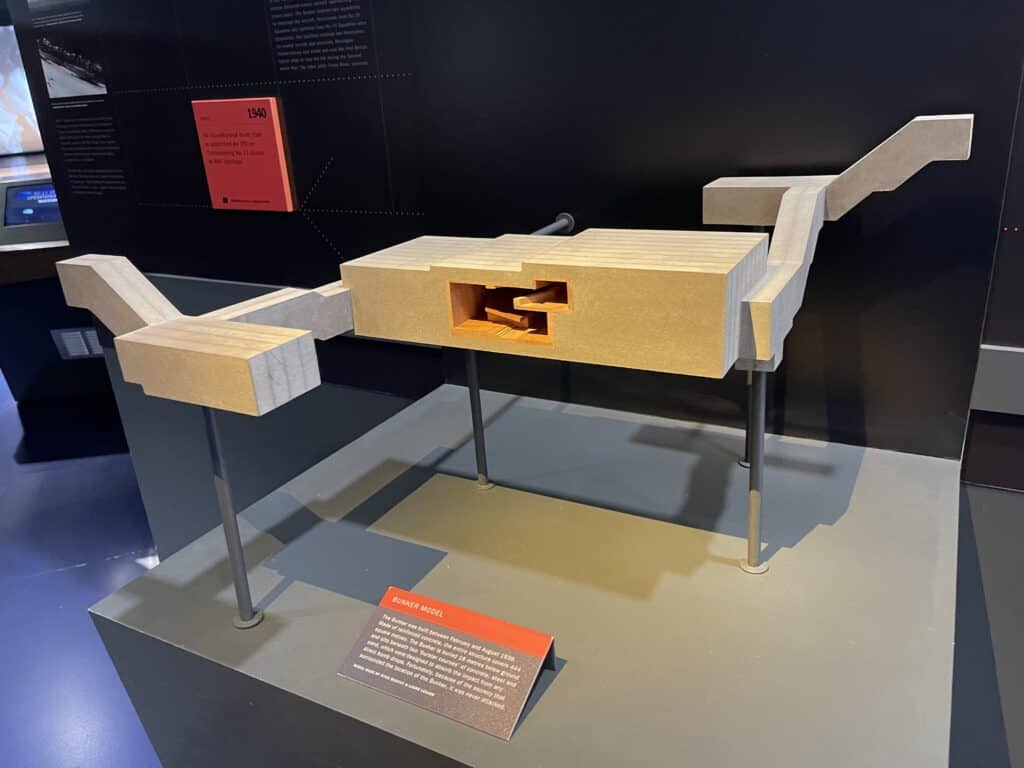
It extends over three levels, including a map, plotting, and conference room. It was designed to accommodate up to 115 personnel, including air-raid wardens, intelligence officers, and other critical military personnel. The bunker remained in use until the end of the war in 1945 and was then abandoned before being restored and opened as a museum in 1978.
Today, visitors can explore the original rooms and see how they were used during the war, providing a unique glimpse into this pivotal historical moment.
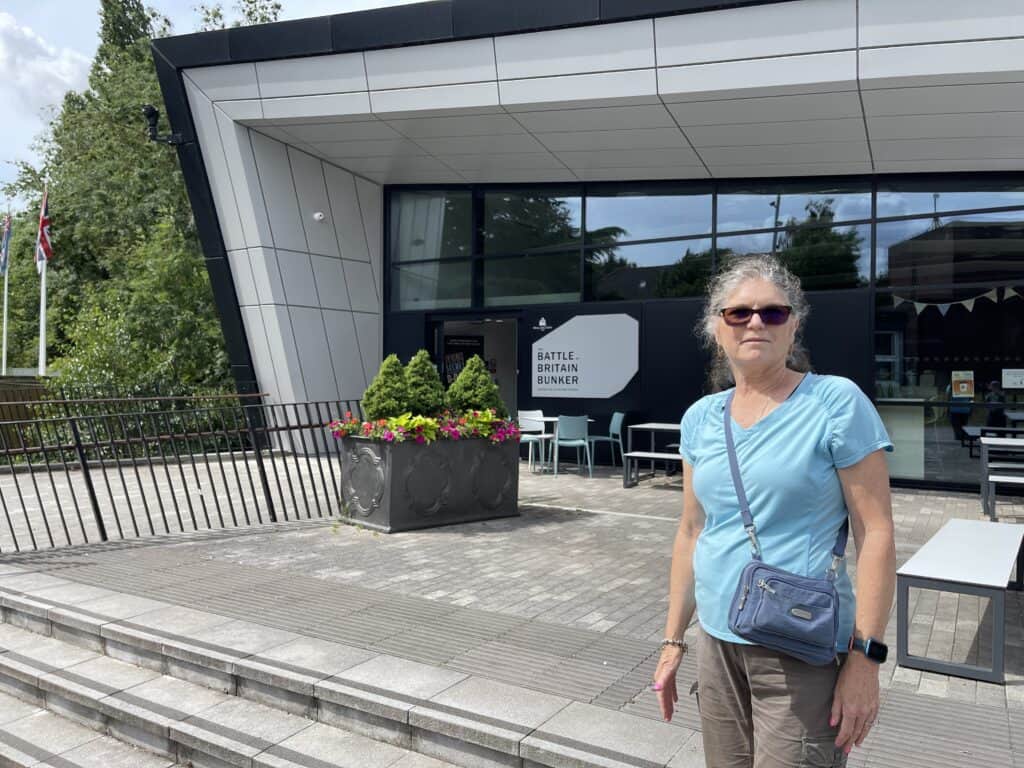
Why Should You Visit This Bunker?
A visit to the Battle of Britain Bunker Museum is more than just an opportunity to learn about a significant historical event. It is also a chance to pay homage to the brave men and women who risked everything for their country during the war. By experiencing this historical site firsthand, you can gain a deeper understanding and appreciation for their sacrifices and impact on shaping the world we live in today.
Visiting the Battle of Britain Bunker
En route to the Bunker, we walked past Hillingdon House, which has a rich history and served as a base for several RAF units in the early 20th century. Upon arrival at the bunker, we were able to get tickets. Tours of the bunker occur at specific times, so if you have time before your scheduled tour, there is much to see in the self-guided museum.
Battle of Britain Bunker Museum – Highlights and Facts
1. Visit the Collection of Memorabilia in the Bunker’s Museum
The museum offers much to see in self-guided museum exhibits. Information displays describe military strategy, events that guided both world wars, and stories about the men and women who contributed to the WWII fighting effort. The exhibits culminate with the story of September 15, 1940 – Battle of Britain Day and the famous D-Day in Normandy.
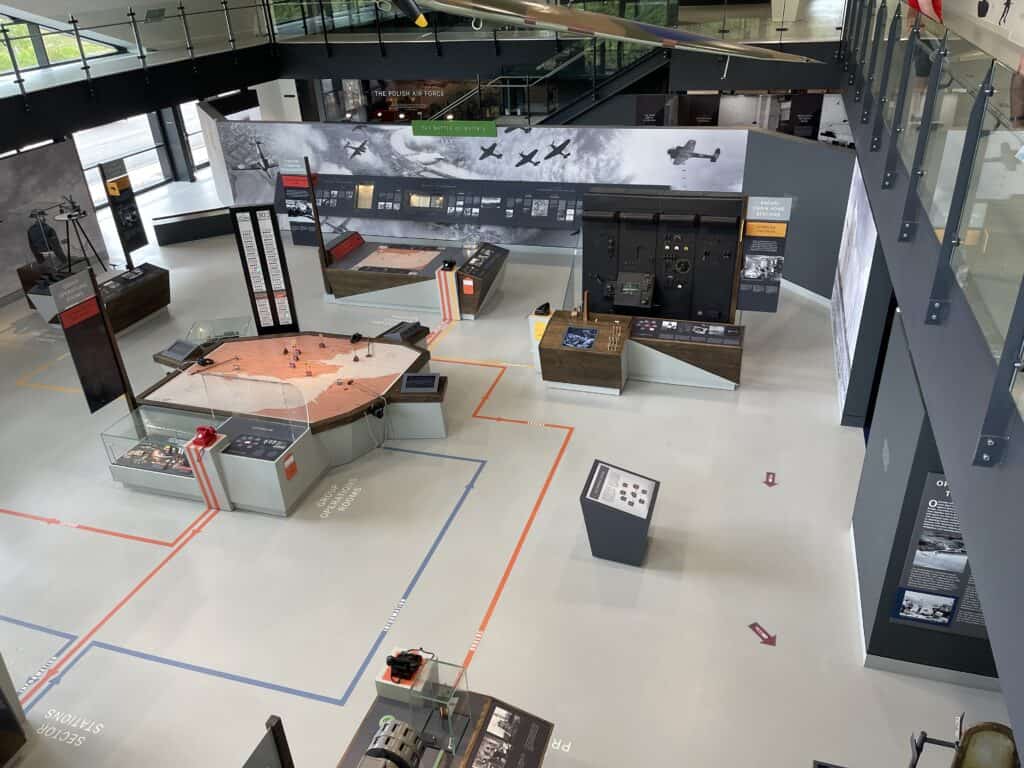
2. Spitfire Aircraft
The Spitfire aircraft played a crucial role in the Battle of Britain, serving as the primary fighter plane for the Royal Air Force. Its speed and agility made it superior to other aircraft at the time, allowing the RAF to defend against German attacks effectively.
The Spitfire’s design also made it easier to repair and maintain than other planes, allowing quicker turnaround times during intense battles. Its iconic shape and sound have become synonymous with the battle, symbolizing British resilience and determination in the face of adversity.
Its maximum speed was 354 mph, making it a close match to the Luftwaffe’s Messerschmitt Bf 109. Spitfire airplanes brought down nearly 500 enemy aircraft during the Battle of Britain.
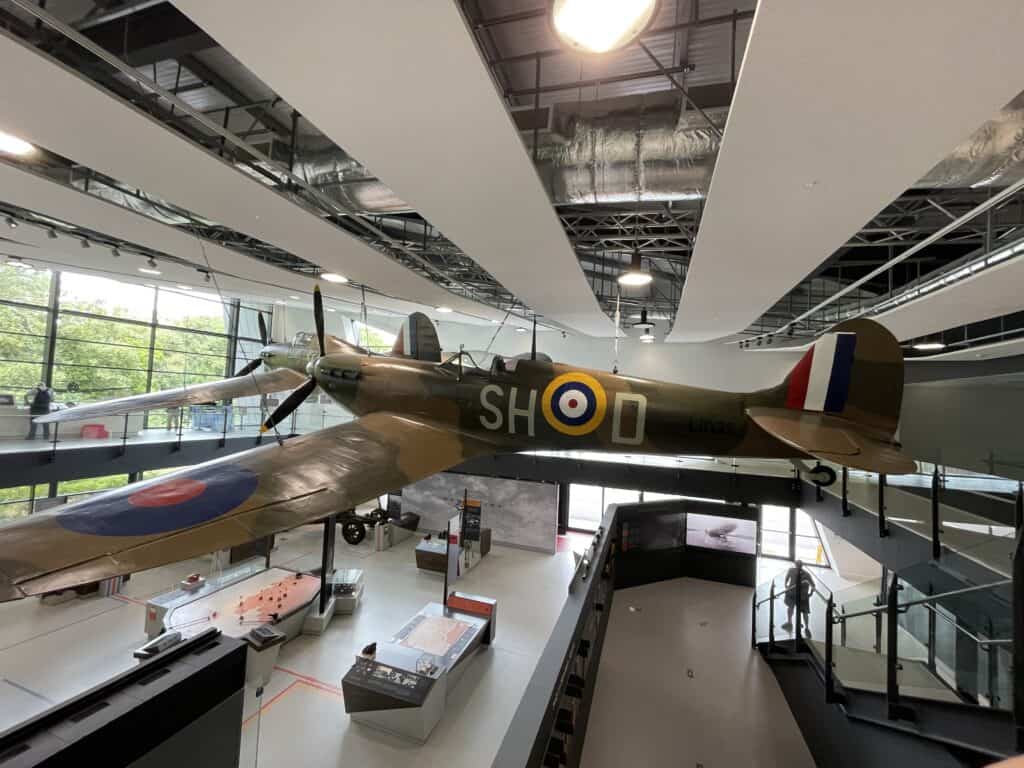
3. Hawker Hurricane I Aircraft
While the Spitfire may be more well-known, the Hawker Hurricane I aircraft was vital in defending Britain’s skies during the Battle of Britain. This workhorse aircraft shot down most German planes during the battle.
Its sturdy design and ability to take substantial damage made it an essential asset in combat. The plane’s construction included a wood and metal framework covered in fabric. This made for relatively quick construction and maintenance.
Its maximum speed of 318 mph made it a formidable opponent against the Luftwaffe’s bombers. While slightly slower than the Spitfire, pilots noted it as a steadier aircraft.
The Hawker Hurricane brought down nearly 1,000 enemy aircraft during the Battle of Britain.
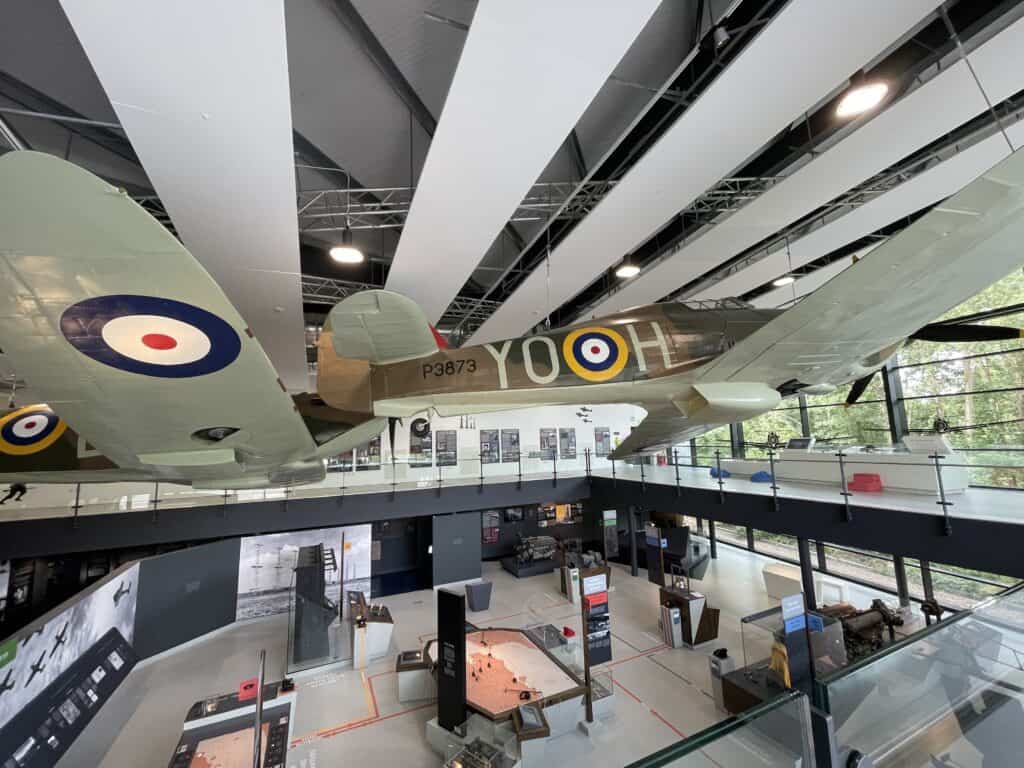
4. The Dowding System
One of the most significant factors in the success of the Royal Air Force during the Battle of Britain was the implementation of the Dowding System. Developed by Air Chief Marshal Hugh Dowding, this integrated network of radars, communication systems, and centralized control allowed for more efficient detection and interception of incoming German planes.
This system gave RAF pilots a crucial advantage in engaging with enemy planes before they reached their targets. Without the Dowding System, the outcome of the Battle of Britain could have been much different. Its impact on modern air defense and military strategies cannot be overstated.
The Dowding System revolutionized air defense tactics and significantly impacted the outcome of the Battle of Britain. By utilizing advanced technology and strategic planning, the RAF successfully defended against the German Luftwaffe and ultimately secured victory. The Dowding System’s legacy lives on in modern air defense systems, serving as a testament to its effectiveness and impact during one of the most crucial moments in history.
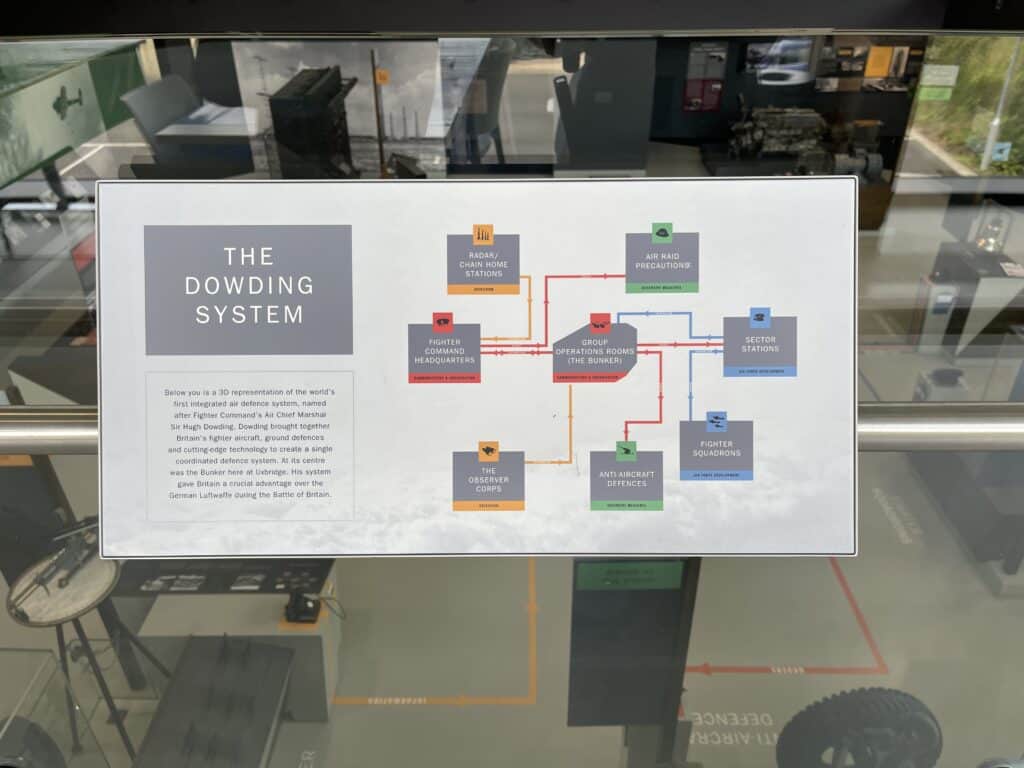
5. A Lake Was Drained
The lake in nearby St. James Park was drained during WWII to prevent German bombers from using it as a landmark.
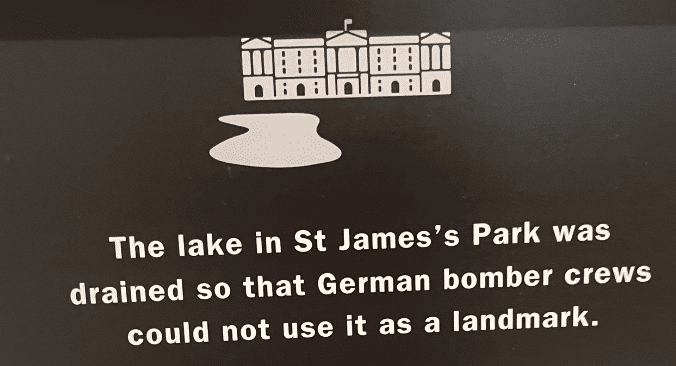
6. Hillingdon House
Hillingdon House, the headquarters for No.11 (Fighter) Group during WWII, played a critical role in the Battle of Britain. Air Vice-Marshal Keith Park, stationed at Hillingdon House, devised the RAF’s successful strategy against the German Airforce, which was implemented in the Battle of Britain Bunker nearby. Additionally, Hillingdon House served as a planning hub for significant portions of the Normandy Landings (D-Day) aerial component. Postwar, Hillingdon House continued to be used by the RAF for education and air traffic control. However, with the closure of RAF Uxbridge in 2010, its military functions came to an end.
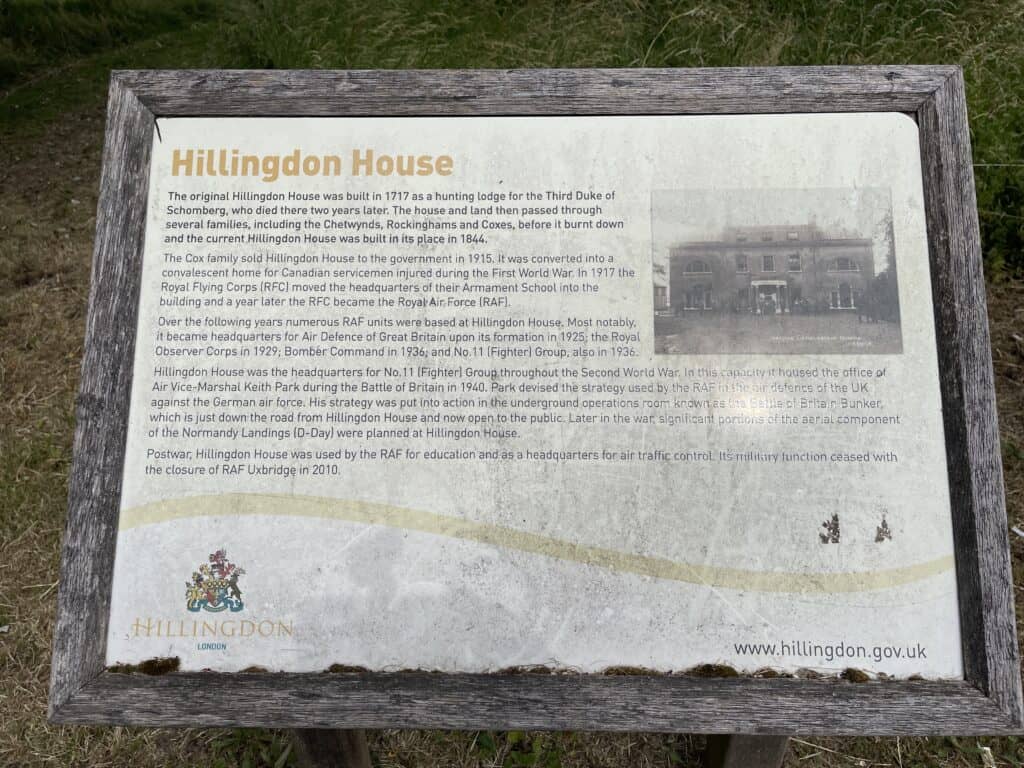
7. Timing was critical
Underground in the bunker, the Group Controller’s job was to monitor the plotting table for enemy movements, decide which squadrons to deploy, and coordinate air defense activity. The Controller had less than two minutes to analyze information and respond to enemy activity.
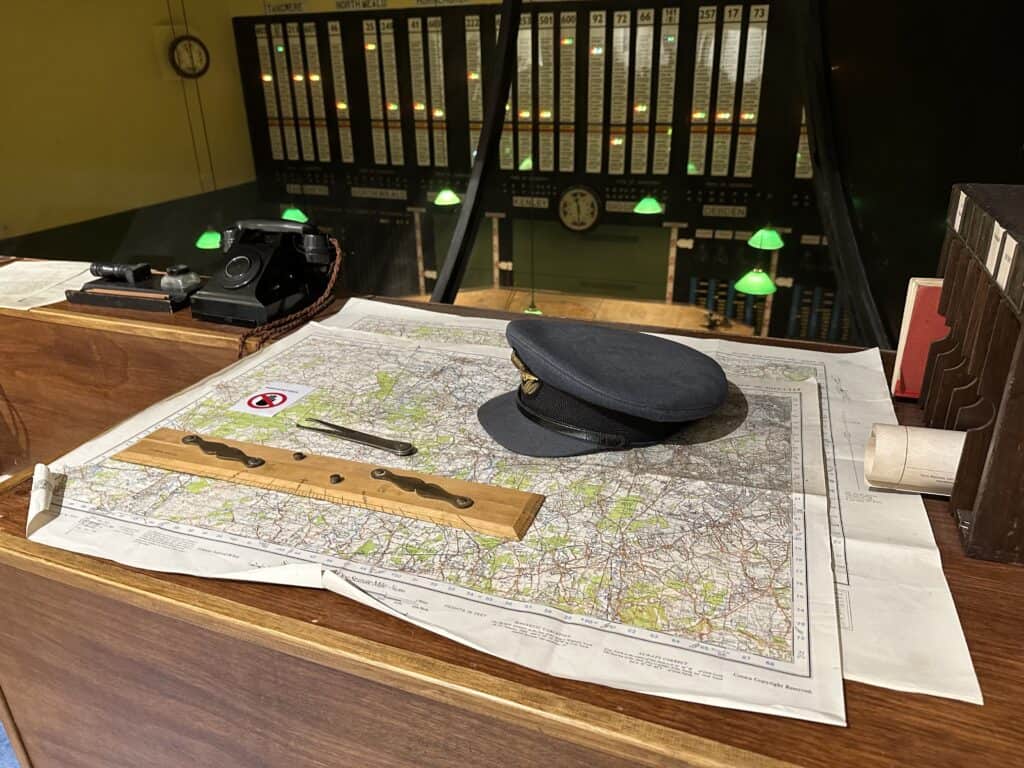
8. William Churchill was present
Winston Churchill was in the Bunker on August 16, 1940. His words at the end of this visit live on in history. “Don’t speak to me; I have never been so moved. Never was so much owed by so many to so few.”
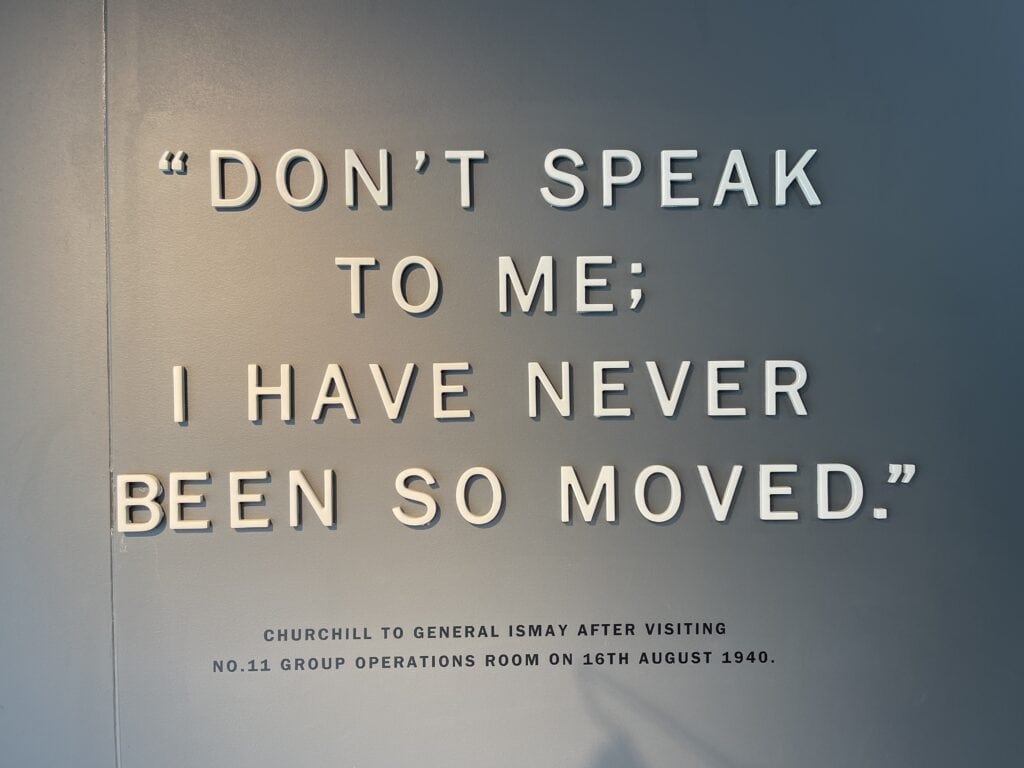
9. Anti-Aircraft guns brought down nearly 300 enemy aircraft
Britain employed several types of air defense systems from the ground. This included anti-aircraft guns, searchlights, and barrage balloons. Anti-aircraft defense was coordinated from RAF Uxbridge. During the Battle of Britain, nearly 300 enemy aircraft were shot down by anti-aircraft guns.
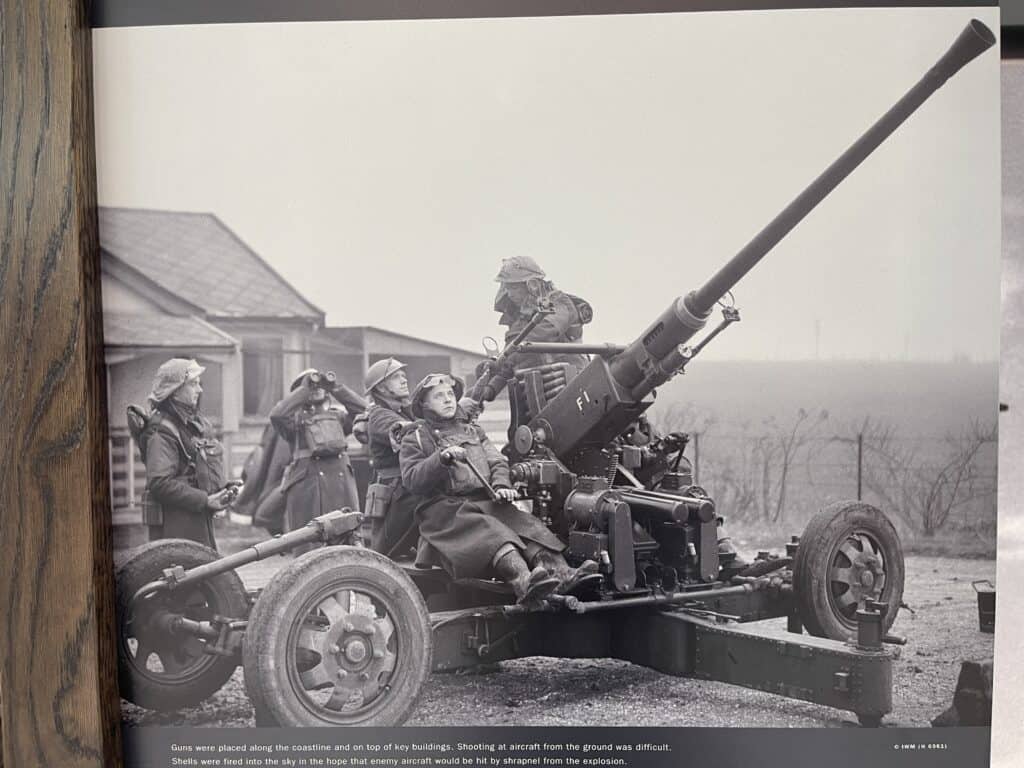
10. Women’s Auxiliary Air Force
Women played an essential role in supporting the war effort. From serving as radar operators to working in factories producing aircraft and munitions, women made significant contributions, allowing for a successful defense against Germany’s attacks.
The Women’s Auxiliary Air Force (WAAF) was established during this time, providing opportunities for women to serve in various roles within the RAF. This included serving as plotter operators, responsible for tracking and plotting enemy aircraft movements on the Dowding System’s plotting table.
At its peak, the WAAF made up 80% of the staff. Most recruits arrived directly from school, barely out of their teenage years. For many, it was their first time away from home.
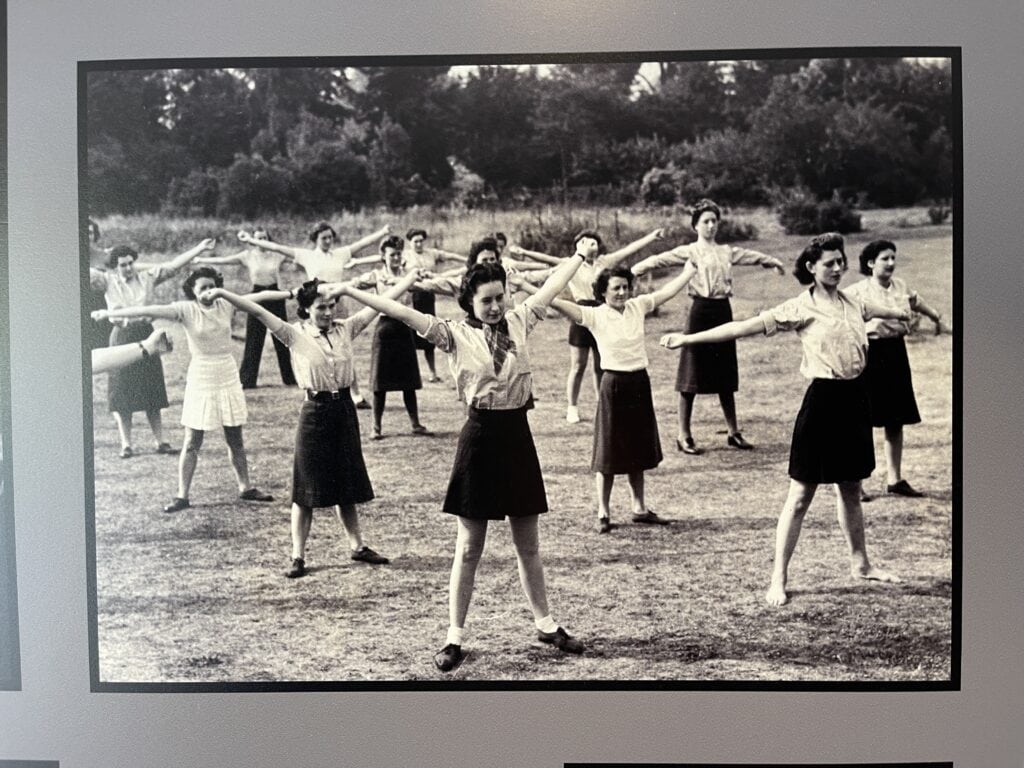
11. Working conditions
Staff at the bunker worked 8-hour shifts as part of their assigned watch. An example shift pattern was 8 am-4 pm, eight-hour break, midnight to 8 am, 16-hour break, 4 pm to midnight. Rotations were always different, and these schedules affected sleep patterns and digestive systems.
The long hours comprised periods of boredom followed by spurts of frenetic activity. Nightshift staff were treated to cocoa and cakes to keep them awake.
12. Polish Air Force Made a Significant Contribution
“Had it not been for the magnificent material contributed by the Polish squadrons and their unsurpassed gallantry,” wrote Air Chief Marshal Sir Hugh Dowding, head of RAF Fighter Command, “I hesitate to say that the outcome of the Battle (of Britain) would have been the same.”
The Polish Air Force was an independent Allied air force, answerable to the Polish Government in Exile. They were under the operational command of the RAF. During the Battle of Britain, over 8,000 Polish men joined the RAF to fight against Nazi Germany. These brave soldiers had fled from their homeland after it was invaded by Germany and continued to fight for freedom and justice alongside the British forces.
The Polish pilots were highly skilled and played a vital role in defending Britain’s airspace. They served in various RAF squadrons, often making up a significant percentage of the pilots in some units. The Battle of Britain Bunker not only commemorates the bravery of these Polish pilots but also serves as a reminder of the strong bond between Britain and Poland during the war.
One of these brave pilots was Squadron Leader Stanislaw Skalski, who became the first Pole to command an RAF squadron. He also played a crucial role in developing tactics used by the RAF during the Battle of Britain. Other notable Polish pilots include Mirosław Ferić and Witold Urbanowicz, who both achieved ace status by shooting down at least five enemy aircraft.
Poland contributed the largest number of non-British pilots during the Battle of Britain (145 airmen). On the day of the famous battle, 20% of the RAF operation’s pilots were Polish.
One of the highlights of our visit to the Battle of Britain Bunker was learning about the vital role of Squadron 303 in the Battle of Britain. This Polish squadron, known as the “Kosciuszko Squadron,” was one of the top-performing units in the battle and played a crucial part in defending British skies against German attacks.
Squadron 303 was the most successful squadron during the Battle of Britain, achieving an impressive record by shooting down 126 German aircraft in 42 days. Despite joining the battle midway, their fearsome reputation was well-deserved as they made the highest number of victory claims.
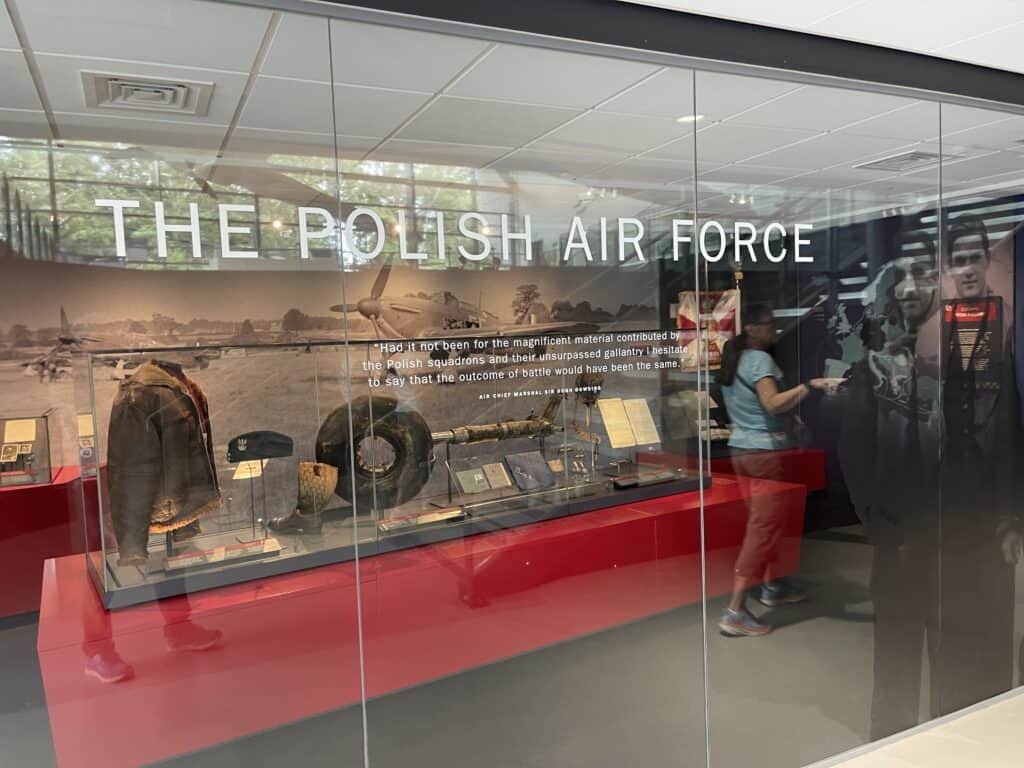
13. Polish Air Force Heritage Trail
The Polish Air Force Heritage Trail provides a unique opportunity to explore and learn about the significant contribution of the Polish Air Force during the Battle of Britain. The trail, located at the historic Battle of Britain Bunker, takes visitors through time with interactive displays and exhibits showcasing the bravery and sacrifice of the Polish pilots and ground crew. Visitors can also walk along the nearby St. James Park, where a memorial was erected to honor the Polish Air Force’s contribution during WWII.
Through this trail, visitors can gain a deeper understanding of the critical role that Poland played in defending Britain against Nazi Germany and how their legacy continues to live on in modern times. It serves as a reminder of the bravery and dedication of those who fought for freedom and democracy during one of the most pivotal moments in history.
Before leaving the grounds, we wandered through the Polish Air Force Heritage Trail – which included an exhibit devoted to the historic Polish Squadron 303. It was at RAF Uxbridge where Group 11 of the Royal Air Force was based, and from August 1940 during WWII, nearly always included at least one Polish squadron.
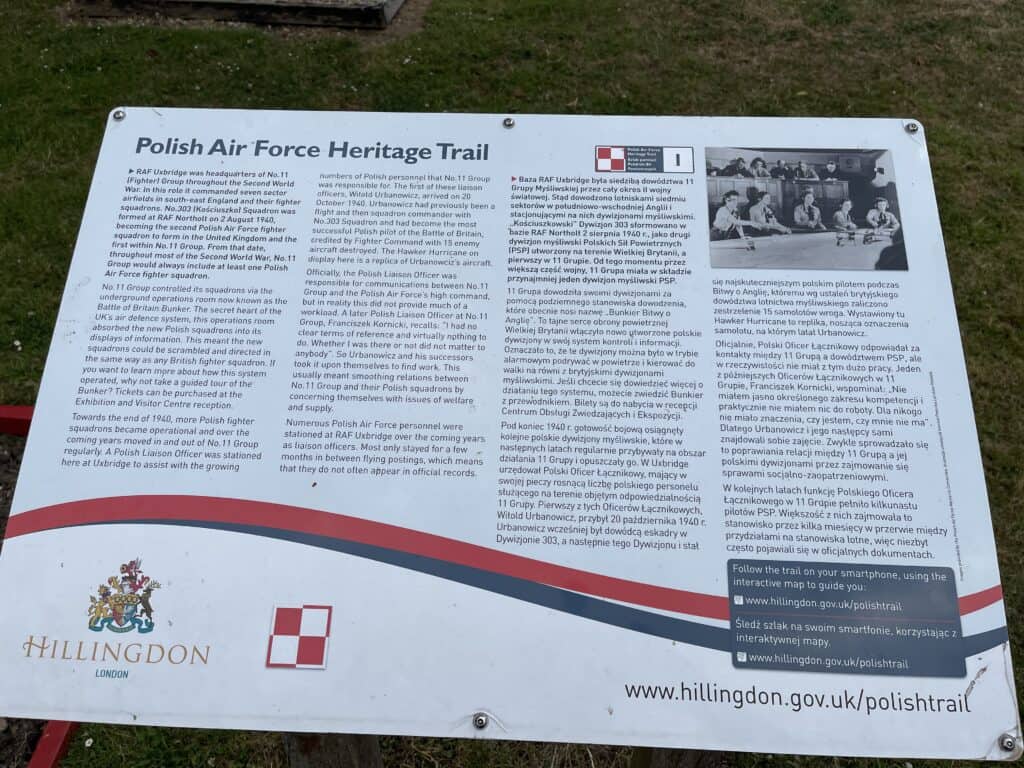
Step into the Bunker for a Unique Historical Experience
Tours are offered that take visitors down into the historic bunker. You will descend 76 steps. We found this descent to be easy. Your experience may vary.
Visitors can explore the original bunker and see where the RAF commanders made crucial decisions that ultimately led to victory. The underground operations room, with authentic equipment and furniture, offers visitors a unique and immersive experience.
The tour was very informative and sufficiently detailed. Being in the room where critical strategic and tactical decisions were made during WWII made history come to life.
Once in the bunker, our tour guide said we could take all the photos we wanted but no video.
The Bunker’s Tactically Strategic Design and Structure
When you enter the bunker, you see a giant map in the center of the group operations room. This was the central area for planning. Here, information was gathered by radar, by spotters in fields, in church towers, and by volunteers with binoculars who would search for enemy aircraft in the skies. If they saw something, they would relay that information into the bunker – absolutely amazing. Our tour guide helped us understand the systems used in WWII that made this bunker operational and functional.
On the large map, teams of people plotted where things were at specific points in time. Information was color-coded by recency. A giant tote board identified the status of aircraft – available, ready to go, in the air. It was very manual and different from how we can do things today in the era of computers. We were impressed at the innovation, and, ultimately, the system worked.
After some time in the big map room, the bunker tour continued with an extended museum area below ground.
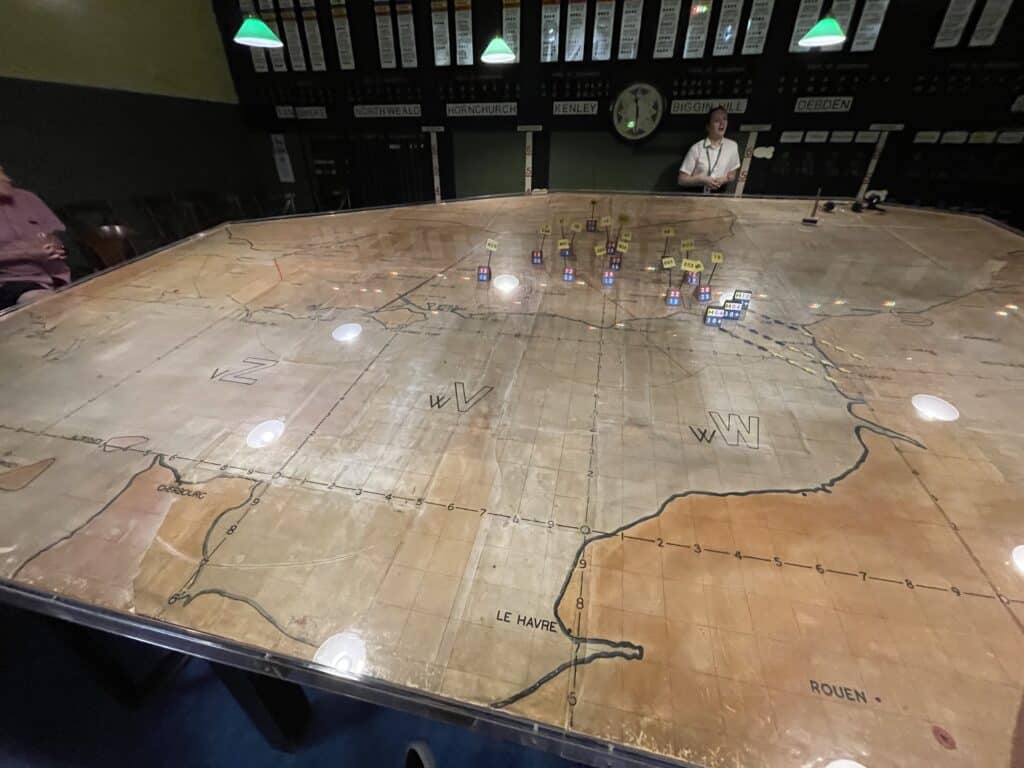
The Impact of the Battle of Britain on WWII
The Battle of Britain was a significant turning point in World War II. It was a crucial air campaign fought between the British Royal Air Force (RAF) and the German Luftwaffe from July to October 1940. The outcome of this battle had a significant impact on the course of WWII.
At the time, Germany had already conquered much of Europe and was planning to invade Britain. However, the RAF’s successful defense against the German air forces prevented Germany from gaining control over British airspace, and ultimately, the invasion was called off.
The Battle of Britain also marked the first significant defeat of Adolf Hitler’s military forces, which significantly boosted the morale of the Allies and decreased support for Nazi ideology. Additionally, this battle showcased the effectiveness of radar technology and air defense tactics, significantly impacting future military strategies.
The contribution of the Polish pilots in the Battle of Britain also played a crucial role in the outcome. Their bravery and skilled flying helped defend British skies, ultimately contributing to the Allied victory. Overall, the Battle of Britain was a crucial turning point that paved the way for Allied victory in World War II.
Battle of Britain Bunker Address
Battle of Britain Bunker
Wren Avenue
Uxbridge
UB10 0GG
Battle of Britain Bunker Website: http://battleofbritainbunker.co.uk/
Getting to the Battle of Britain Bunker
Directions by Public Transport
The Battle of Britain Bunker is in Uxbridge, a town in the London Borough of Hillingdon. It is easily accessible by public transport, with Uxbridge station being the closest Tube station.
To get to the Battle of Britain Bunker from central London, take the westbound Metropolitan or Piccadilly line from any central London station towards Uxbridge. The journey takes approximately 45 minutes. Once you arrive at Uxbridge station, the bunker is a short walk away.
Take the main exit, turn left onto Bakers Road, and then another left onto Hillingdon Road. Follow Hillingdon Road until you reach the roundabout, where you will see a sign for the Battle of Britain Bunker. Turn right onto Warren Road, and you will reach the entrance to the site.
For visitors using public transportation to arrive near the Bunker, we recommend using your phone navigation if available and specify walking directions. While signs are posted as you leave Uxbridge Station, they are primarily intended for car traffic.
For our visit, once off the tube, it was about a 20-minute walk to the Bunker. It was easy to find with Google Maps on our phone – which helped as the street signs showed directions intended for a car. By walking, you can save time by cutting through Dowding Park – which you’ll miss if you don’t have this pre-mapped out on your map program.
Directions by Car
If you’re planning to drive to the Battle of Britain Bunker from central London, it is approximately 18 miles and takes around 45 minutes, depending on traffic.
- Take the A40 west towards Oxford.
- Continue on A40 until you reach Hillingdon Circus roundabout.
- At the roundabout, take the third exit onto Uxbridge Road/A4020.
- Continue on Uxbridge Road/A4020 for approximately 3 miles until you reach Hillingdon Underground Station.
- At the next roundabout, take the second exit onto Long Lane.
- Follow this road until you see signs for the Battle of Britain Bunker. Take a left onto Warren Road, and you will arrive at the site.
We recommend using a navigation app or program to help guide you, as many turns and roundabouts are on the way.
Frequently Asked Questions – FAQ
The Battle of Britain Bunker, located in Uxbridge, west London, is about 60 feet (18 meters) deep underground. This bunker was the heart of Britain’s air defence system during the Second World War and is a significant part of the country’s history. It housed operations rooms for Fighter Command’s No. 11 Group, responsible for the aerial defence of London and southeast England during the Battle of Britain.
Yes, parking is available at the Battle of Britain Bunker. The parking is free for all users and is in front of the venue. The car park type is open air/surface. There are also parking spaces specifically reserved for Blue Badge holders.
What We Liked About This Museum
We appreciated that it was focused primarily on a singular event. That reminded us of the Churchill War Rooms, making it easier to comprehend. In comparison, the RAF museum in London spanned decades.
There were a few broader topics presented at the Bunker’s museum exhibits, such as the history of radar development – but most of the focus was on the people who served at this bunker and their involvement in the Battle of Britain and D-Day.
We also enjoyed learning about life for the people who served here – about 80% of whom were women.
Outside the museum, fly the flags of 15 nations that provided fighter command with airmen during WWII.
Listen to our Battle of Britain Bunker Podcast
Watch our Battle of Britain Bunker YouTube Video
Related Places to Visit
The Trenchard Museum – Step into History at RAF Halton
Conclusion
A visit to this museum typically takes around 1-2 hours. For history buffs and aviation enthusiasts, it is easy to spend longer exploring and learning about the crucial events in this bunker.
We enjoyed our visit here. The Battle of Britain Bunker Museum is a must-visit for anyone wanting to understand the RAF’s role in World War II and commemorate the brave men and women behind the scenes who fought in WWII. We highly recommend it for history and military buffs.
Visiting this bunker is not just a trip through history but also an opportunity to pay tribute to the brave men and women who fought and sacrificed their lives for our freedom. From interactive exhibits to immersive experiences, the Battle of Britain Bunker offers a unique and engaging way to learn about this important chapter in history.
Thanks for reading. We hope to see you at the places where we go.
Julie & Art
#battleofbritain

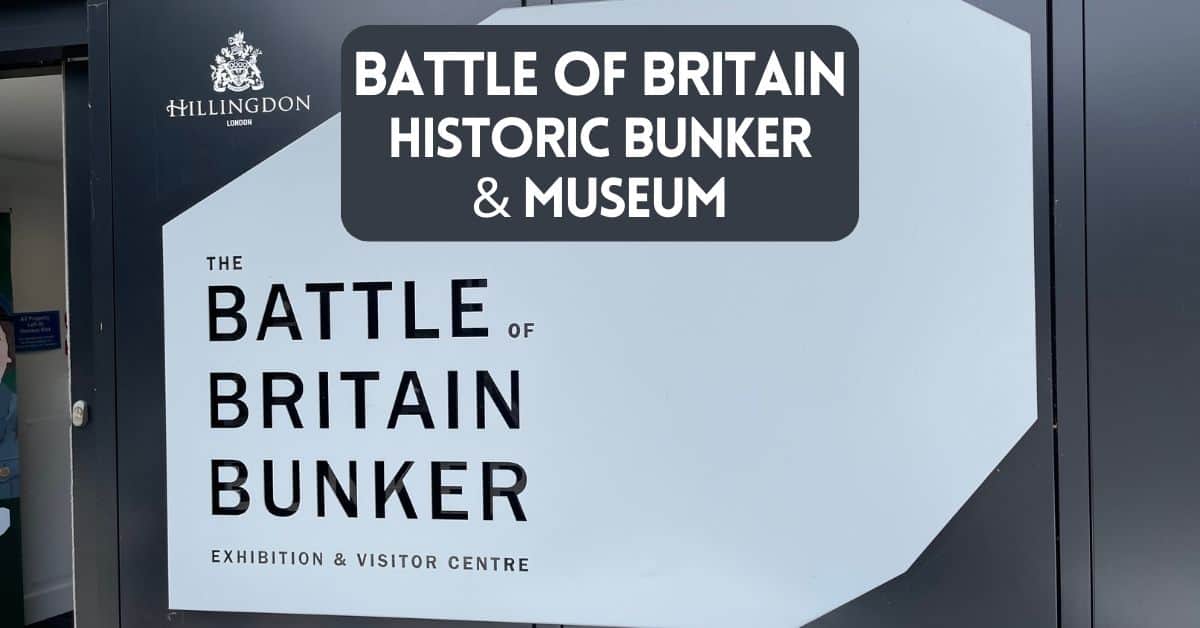
2 Comments
Comments are closed.